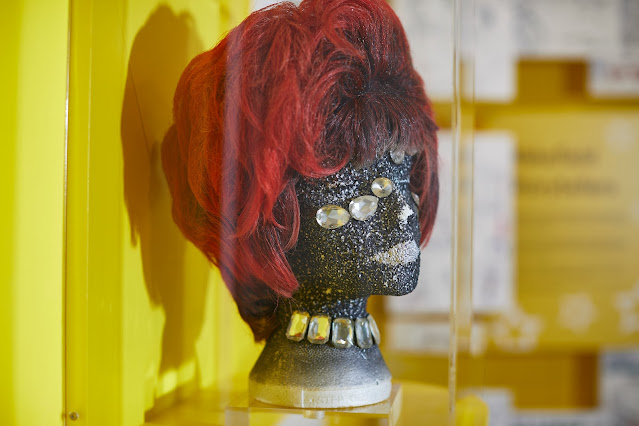Lydia, a Modern History MA student on placement with us from the University of York, has been exploring the treasure trove of our oral histories collection to support the ongoing evolution of our new Moving Stories exhibition.
Here’s what she’s uncovered in our Rainbow Trails oral
history archive, a compilation of Wakefield’s LGBT+ stories!
The ‘Wakefield Storytellers’ section of the Moving Stories
exhibition is dedicated to showcasing stories from local people. Some of these
were already in our oral history collections, and others are new ones we are
collecting all the time.
Given this year’s LGBT+ History Month focus on ‘Behind the Lens’, I have been exploring stories from Wakefield’s local LGBT+ stars and
allies, both on and off the stage.
Let me introduce local legends Sue Riley and Madam Connie!
Sue grew up making her own clothes. She recalls that most people did when she was younger, and she always helped others with their clothes when asked. After moving to Wakefield in the 1990s, Sue met local drag queen Madame Connie at the Fernandes Brewery pub. Soon after learning about Sue’s talents, Madame Connie gave Sue her first ever drag outfit commission. This was a partnership to continue for many years, as Sue explains in the clip below:
Sue made an array of dresses from all sorts of unsuspecting materials and took to the challenges given to her by Wakefield’s drag performers. One of her favourite dresses that she made for Madame Connie was this black velvet dress with hologram sequins and golden wings.
 |
| Madam Connie slaying the house boots down in her Norma Desmond outfit! Photo copyright of Sue Riley, early 2000s |
In the audio clip below, Sue describes stepping up to the challenge of creating this iconic dress!
Another challenge was presented to Sue when she was asked to
fashion a dress out of white and brown cow print material. She designed a rock
and roll dress with lots of frilly petticoats at the request of the drag queen.
When she realised she had leftover fabric, Sue designed something extra for the
performer... Listen to the clip below to find out what this was:
Clearly, this line of work was destined for Sue as her
flourish for creativity matched the vibrant looks the drag queens wanted to
create.
Sue’s work was incredibly important to Wakefield and the
local LGBT+ community. Performing on stage allows people to create other
personas and step out of their comfort zone; the creation of these dresses
helped solidify these characters on stage and gave the performers the
confidence they needed.
Drag came to the stage many years ago in theatre
performances and has continued to develop in recent years and is now even
present on television shows. Drag was never about impersonating a woman or a
man; it was about an exaggerated performance to create a new identity. While
drag was less accepted in the past, some still broke through the barrier and
began to make changes. One of these iconic performers was Sue Riley’s favourite
drag queen, whom she had seen perform live, Danny La Rue.
Drag impacts our lives more than you can imagine; even some of today’s slang comes from the drag industry.
But instead of continuing, here's a bonus clip from Steven spilling the 'T' on what Madam Connie means to him:
We are proud to tell Sue Riley's story and spread the word about
her work #BehindTheLens.
Please look out for our future engagement with Wakefield’s
LGBT+ stories, and if you have any memories to share or pictures of Sue Riley’s
dresses, or Madam Connie's performances, please tweet us or email
us at museums@wakefield.gov.uk.
We also have one of Madam Connie's wigs on display in the new Moving Stories exhibition at Wakefield Museum!
 |
| One of Madam Connie's wigs, worn at performances in the early 2000s. Photo credit Nick Singleton |
We can’t wait to hear more of Wakefield’s LGBT+ stories!

No comments:
Post a Comment
We would love your comments - though they may take a day or two to appear.